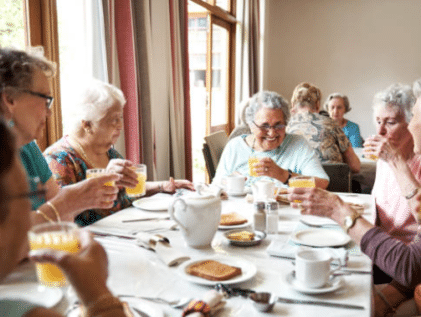If you’ve ever toured assisted living communities, you know it’s easy to get caught up in the buildings themselves – how new or updated they are, whether their fitness equipment is state-of-the-art, or what the grounds look like. And while the quality of facilities should be a big priority in the discernment process, a prospective community’s approach to resident engagement is one of the most critical aspects to consider when choosing senior housing. How residents spend their days – the quality and range of choices they have about how to stay active, learning, and exploring – is what ultimately determines their quality of life.
The assisted living industry as a whole has evolved over the last few decades to recognize this, and at its best strives to create an environment that meets seniors where they are – as educated people who have lived busy, enriching lives, and who expect to maintain that lifestyle. To get a sense of what this approach looks like on the ground, we recently spoke with Resident Engagement Director Courtney Allenson, who manages community engagement at The Residence at Otter Creek.
What areas of interest are you looking to fulfill with Otter Creek’s engagement calendar – fitness, art, civic engagement, etc? How do you decide what to offer?
If you looked at the course offerings of a liberal arts college, you would get an idea of the range of interests I want to address – art, culture, ecology, economics, language, history – plus the areas of physical wellness, social interaction, cognitive engagement, and emotional wellbeing. Our engagement calendar offers multiple opportunities to engage on multiple levels, every single day. I never hear residents say there’s nothing to do. What they do say is, “there’s so much to choose from. I wish I could do it all but I can’t.” This makes me so satisfied!
Our classes, events, lectures, and discussions are based on past successes (what’s been popular before), novelty ideas (what’s new to us and what isn’t being offered at other senior communities), and what residents want. We meet monthly so that residents can offer input and guidance, but I also get calls, emails, and notes all month long with suggestions. And that’s the way it should be, because it’s their calendar; I want it to address their personal interests, needs, and goals.
I also reach out monthly to local professors, musicians, artists, theaters, and more to collaborate on programs for Otter Creek. Our residents are intelligent, well-traveled people who are always looking to learn something new! I also work with residents and their family members who may want to share their profession, passion, or hobby with our community.
Can you walk us through what a typical day might offer at Otter Creek?
Our minimum number of programs per day is six, but more often we have ten to twelve activities going on. Every day we have several types of exercise; depending on the season, choices could include aqua aerobics, walking, hiking, skiing, tai chi, yoga, balance and flex, OTAGO, bone builders and outdoor games like bocce and croquet. We also have lectures once or twice a week, live music multiple times a week, lively discussion groups, writing/poetry sessions, art classes, craft classes, horticultural opportunities and more.
We also often travel off-site to places like Town Hall Theater and Middlebury College for art exhibits, lectures, plays, and live music.
For those folks who can’t always attend programs in the common spaces, we’ll meet them where they are. We recently hired a therapeutic harpist who plays in two areas of the residence where people can easily just step out their door. In just four months, we’ve seen a dozen people join into this experience who hadn’t been involved otherwise.
Every day I see residents who are engaged, empowered, learning, exploring, and having fun. Seeing them so fulfilled makes me fulfilled, and it’s how I know we’re meeting our mission here at Otter Creek.

